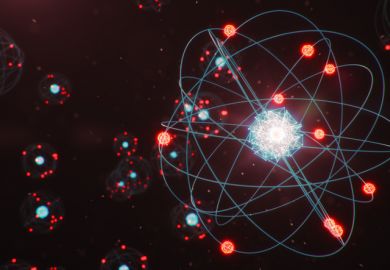There is a story familiar to any mathematician: at any party or social function the usual ritual begins over who does what and where. As soon as the terrible secret is out that one is a mathematician, a temporary but chilling silence descends, accompanied by a shuffling of feet. "I was never very good with numbers," says someone, usually followed by tart remarks about mad mathematicians who do not know what year it is, never mind the month. There is usually one earnest soul who asks reverential questions about the millionth decimal place of pi or the set of all sets. Such people drive me screaming to a far corner of the kitchen to find solace in a bottle of red wine.
It has therefore come as a revelation to most mathematicians to find that there is now a topic that has become positively fashionable to talk about. The weather, stock market fluctuations, patterns in dried mud in archaeological digs or even the atmosphere of Jupiter can all be airily explained to an admiring audience with a wave of the arm and one magic word - chaos.
It was in 1978 that a friend pointed out to me a short paper, published in 1963 in the Journal of Atmospheric Sciences by an American meteorologist From the Massachusetts Institute of Technology, E. N. Lorenz, entitled "Deterministic nonperiodic flow". In it, Lorenz extracted a highly simplified set of three ordinary differential equations out of the main equations for fluid flow using a severe truncation. The main equations for a fluid (the Navier-Stokes equations) are highly complicated and impossible to compute properly, even today. The results were what have now become known as "the Lorenz equations". In the paper, Lorenz analysed their properties and discovered the random behaviour of solutions in various parameter regimes. What was intriguing was that the solutions of a simple deterministic set of differential equations appeared to be chaotic. Much has been written about subsequent events and discoveries, not least in one of Ian Stewart's earlier books Does God Play Dice?
In one sense, Edward Lorenz's book is his own version of the chaos story: how he came upon the phenomenon and where it has subsequently led. As a topical book, it comes relatively late in the day, since more dramatic accounts have previously been written by others. There is no harm in this, as Lorenz, the modern discoverer of chaos, has a special place in the subject that others cannot fill. The Essence of Chaos is a beautifully written, thoughtful book which eschews the philosophising so prevalent in science writing today. His clear and lucid explanations of problems in weather forecasting, including some personal stories of how and why he became interested in the problem, are a pleasure to read. The book is almost completely equation-free, which many who are not mathematicians would see as a bonus, although it does have an appendix called "Mathematical Excursions" and a technical glossary at the end. It is definitely readable by those who enjoy general science reading and I recommend it highly.
Jack Cohen and Ian Stewart's book is of an entirely different stamp. While Lorenz's book is his personal equivalent of Does God Play Dice?, this jointly authored book takes the discussion a stage further. Its unusual semi-futuristic, almost science-fiction style, will greatly appeal to the young, particularly those steeped in the computer and science-fiction world. Moreover, it is a very clever, inventive book in the way it uses every conceivable literary and scientific device to get its ideas across to the reader. While I do not necessarily agree with everything in the book, it is clear that a great deal of time and thought must have been given to its writing; and the authors admit that some of their ideas may be controversial.
At the heart of the book is a discussion of complexity and simplicity. Which of these is the most natural? Must the question be either/or? In the first half, the authors make the standard reductionist case for human culture, intelligence and behaviour being governed by the laws of physics via the chemistry of DNA. They illustrate the point by leading the reader step-by-step through the first few chapters, weaving in and out of examples of how western science has tended to look for the explanation of observed phenomena in terms of low-level simplified models, laws and theories. It is certainly true that elegant simplicity has always been highly prized in these areas. When the idea of chaos and complexity appeared, many did a double-take over the idea that things may not be so simple after all. Then the authors ask "Why is there simplicity?" They argue that while simplicity may in fact come from complexity, the formal rules by which this may occur are not clear. They also argue that reductionism is full of gaps but their proffered attempts to fill these gaps lack a certain precision. Their central claim is that a mathematical justification is needed for the belief that simple high-level rules, not only can, but usually do, emerge from complex interactions of low-level rules.
J. D. Gibbon is professor of applied mathematics, Imperial College, London.
The Essence of Chaos
Author - Edward N. Lorenz
ISBN - 1 85728 187 X
Publisher - UCL Press
Price - £14.95
Pages - 2pp



